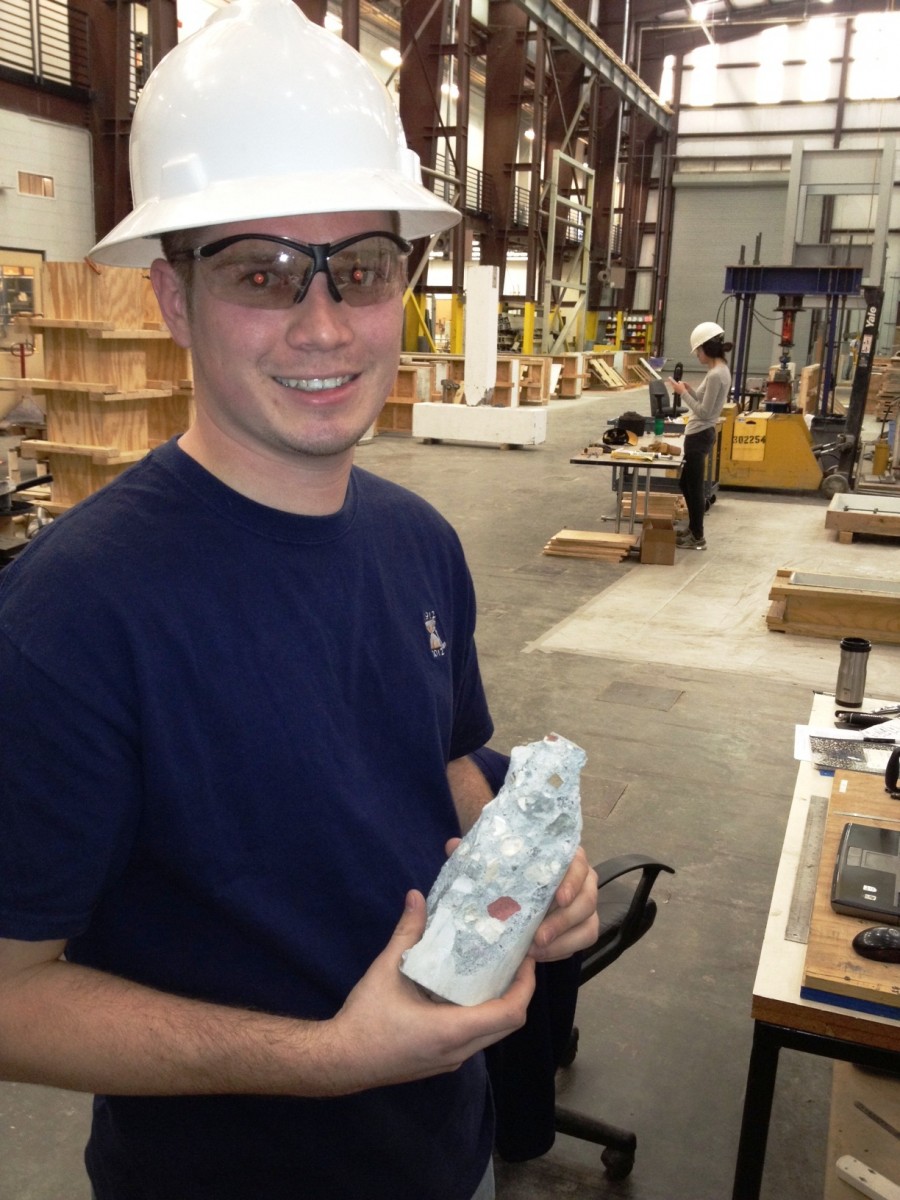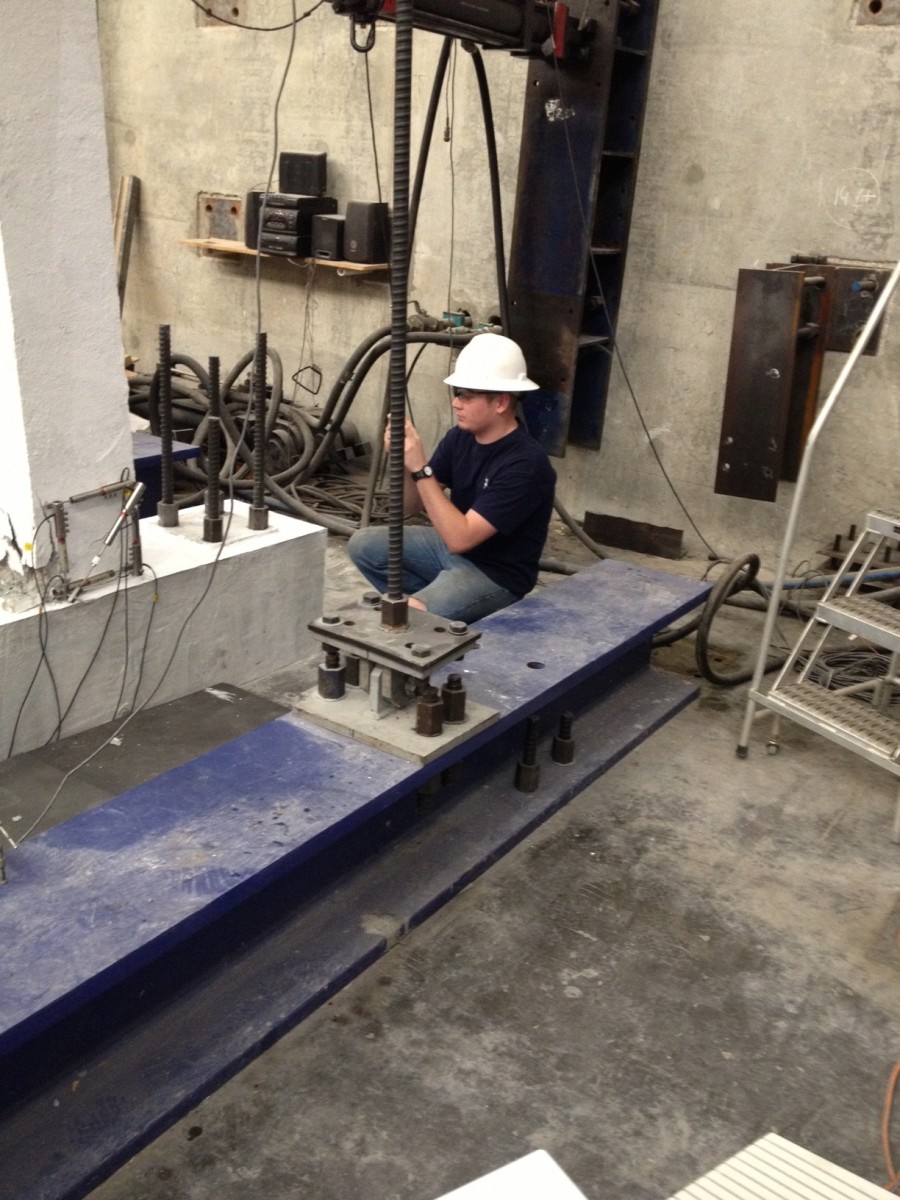
 Graduate student Mitchell McKay is scheduled to receive his master’s in structural engineering on Dec. 14, but the 24-year-old Macon native figures he’s got a little more work to do.
Graduate student Mitchell McKay is scheduled to receive his master’s in structural engineering on Dec. 14, but the 24-year-old Macon native figures he’s got a little more work to do.
“I’m a non-thesis grad student, so this is not required, but, over Christmas, I want to write up my research,” says McKay, a researcher with CEE’s Caribbean Hazard Assessment, Mitigation, and Preparedness (CHAMP) team.
“We think we can get this research published in a journal, which is pretty exciting, and that’s really the only time I’ll have to do it. I start my new job [at the Kennesaw-based Enercon] on December 31.”
McKay’s research, "Seismic Performance of Columns with Recycled Concrete Debris," focuses on the viability of using non-virgin coarse aggregate –specifically crushed concrete construction waste - as material for new buildings.
His dedication to this final project does not surprise anyone who has worked with him.
“Mitchell is a perfect example of the creativity and resourcefulness that we see in our Georgia Tech students,” says Dr. Reginald DesRoches, one of his faculty mentors.
“He was able to collect the data by asking the right questions, and design an experiment that could lead to breakthroughs in the use of recycled materials for earthquake resistant buildings. The skills that he developed in this project will serve him well in the future.”
 Recycled aggregate is already used by some states as fill and underlying pavement, McKay said, but it has not been widely used in reinforced concrete structures in the United States. If successfully developed for use in structures, recycled construction debris could become a useful resource for the earthquake-prone countries of the Caribbean, where access to new building materials is often limited and landfilling of debris is costly.
Recycled aggregate is already used by some states as fill and underlying pavement, McKay said, but it has not been widely used in reinforced concrete structures in the United States. If successfully developed for use in structures, recycled construction debris could become a useful resource for the earthquake-prone countries of the Caribbean, where access to new building materials is often limited and landfilling of debris is costly.
“Before we can get there, we have to see how recycled materials handle conditions that approximate a disaster,” McKay said. “We have to get data.”
McKay has been gathering that data throughout his undergraduate and graduate careers at Georgia Tech. A charter member of CHAMP, he has done research on the ground in Belize, Puerto Rico, Jamaica and Trinidad. In each of these countries, he joined other student researchers and CEE faculty who spoke with contractors, visited cement and concrete plants, and studied the relevant building codes – all in an effort to see whether recycled debris could be used for reconstruction after a disaster.
McKay’s research team was also interested in making sure that the new building materials could withstand the stress of an additional disaster. Little research has evaluated the performance of recycled aggregate concrete under earthquake loading, so McKay decided to focus his graduate research there. He recently presented his preliminary findings at the fall convention of the American Concrete Institute (ACI) in Toronto.
 McKay was excited to speak with professionals in the field, but he reserves most of his enthusiasm for the capstone research he completed just weeks before receiving his master’s degree. In a series of seismic loading tests, McKay’s research team observed four concrete columns, each with different composition and reinforcement properties.
McKay was excited to speak with professionals in the field, but he reserves most of his enthusiasm for the capstone research he completed just weeks before receiving his master’s degree. In a series of seismic loading tests, McKay’s research team observed four concrete columns, each with different composition and reinforcement properties.
Two of the columns contained coarse aggregate that was 80 percent recycled from construction debris, and two used a virgin aggregate. The steel reinforcements in two of the columns were varied as well.
“In the United States, we have pretty exacting codes for steel reinforcements in buildings, so we had two columns that met those standards – one made from virgin aggregate, one from recycled materials,” he said.
“But in other countries, particularly the Caribbean, the structures are typically under-reinforced. The codes and practices are different. We had two columns that were under-reinforced, so we could see how that affected their performance.”
To simulate the energy disbursed in a typical earthquake, each of the columns was subjected to about 25,000 pounds of sustained pressure, applied through a vice-like “actuator” arm that extended from the wall of the CEE Structures Laboratory.
“We’re looking at energy dissipation,” McKay said as he watched the actuator press on an under-reinforced column made of virgin aggregate. “We want to see how much energy they can absorb and still stand.”
McKay said that structural engineers will need to investigate several variables before this process is embraced by the construction industry. Consistency is a big consideration, for instance.
“Some recycled aggregate might be stronger than others, so we might have to look at the feasibility of getting recycled aggregate from different sources, to ensure quality. That’s not something we looked at,” he said.
“With this project we went to great lengths to get recycled aggregate that was high in limestone content because that’s similar to what you’ll find in the Caribbean nations. In Georgia, we typically use granite, which is stronger.”
While the data from the earthquake testing must be analyzed, the initial results seem promising.
“Mitchell and his team have done an excellent job evaluating the seismic resistance. This data is needed before this approach can be used practically, and the results are very encouraging,” says Dr. Kimberly Kurtis, one of his faculty mentors.
“In the Caribbean, corrosion of reinforcing steel is also a concern. We need to evaluate more materials and develop mix designs to ensure that concrete produced from debris will not only withstand earthquakes but will also be durable in the Caribbean.”
Kurtis said the CHAMP program will continue to pursue this research, funding pending, and she invited interested students to inquire about future opportunities.
